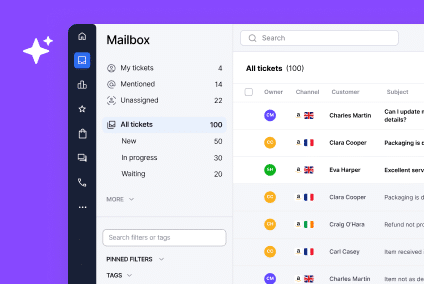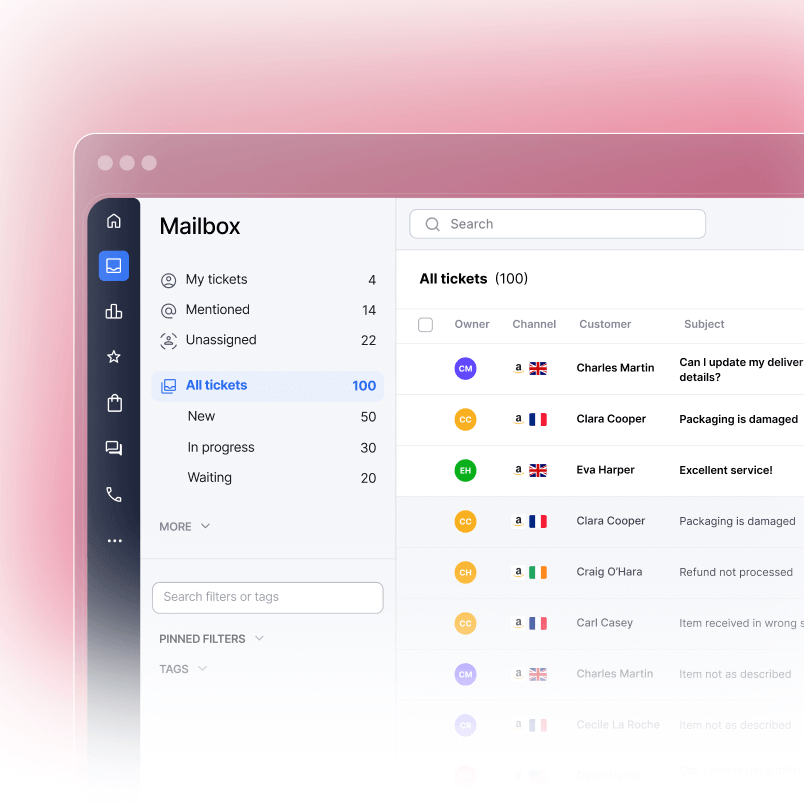Creating exceptional customer experiences is something every modern business strives for. Delivering delight and knowing how to handle angry customers is crucial, but it’s not always easy. Particularly in the eCommerce space, customer expectations are higher than ever as shoppers demand better online experiences. On top of this, retailers worldwide continue to grapple with ongoing supply chain challenges and evolving customer expectations.
Angry customers are something that all online sellers will have to deal with at some point. According to recent statistics, 4 in 10 agents report that when consumers cannot complete tasks by themselves, they become angry. Additionally, more than half of consumers will switch to a competitor after just one bad experience. Find out how to turn these challenging situations around and deliver a positive outcome.
Against the backdrop of this dynamic landscape, every retailer must accept the unpredictability inherent in the business. That is, as diligent as online retailers are about keeping their customers happy, there will be hiccups, and things are bound to go wrong occasionally. Despite a business’s best efforts to anticipate issues, there will inevitably be scenarios when products are difficult to source and deliveries are delayed, resulting in customer complaints.
However, viewing today’s challenges from a growth perspective allows retail businesses to find new ways to solve problems. Paradoxically, the issues and resulting customer complaints can often lead to positive outcomes, as long as businesses work strategically to handle irate customers and turn them around by delivering excellent customer service.
Why it’s so important to deal with angry customers and offer great customer service
Experiencing an angry customer, while unfortunate, is often unavoidable. When a poor customer experience occurs, it is never too late to mitigate and certainly never too late to learn from it. Think of it as an opportunity to learn, by turning a negative situation into a positive customer experience. How a business reacts to a disgruntled customer can make or break their perception of the brand.
Instead of fearing an angry customer, a business with a growth mindset can use the situation to improve its product or service and build a better relationship, by developing the right customer service mindset.
According to management consultancy group Accenture, companies lose a whopping $1.6 trillion a year due to customer churn. In addition, only 1 in 25 customers will complain to the business about their experience. That means that most customers don’t communicate to companies that they’re not happy. This is a red flag to retailers, who stand to lose out massively if they can’t rectify problems that they aren’t aware of.
Businesses should treat every complaint as a gift. Complaints are packed full of insights that can help customer service teams improve and, in turn, deliver value to other unhappy (but silent) customers.
Here are ten proven strategies on how to handle angry customers in eCommerce. Spoiler: it all comes down to establishing customer loyalty.
1. Listen to upset customers
Practice active listening rather than passive listening when customers are angry. Active listening means concentrating on everything the customer is saying, so you clearly understand why they’re upset. Passive listening means only absorbing part of the message and not paying full attention to the emotions behind their communication.
“Most people do not listen with the intent to understand; they listen with the intent to reply.” Steve Covey, author of ‘The 7 Habits of Highly Effective People’.
Be present and give the irate customer your full attention. Read the customer’s enquiry twice before you respond. Focus on the words they’re communicating and not the anger behind their words.
To show the customer you’re actively listening, paraphrase their complaint, ask clarifying questions, and don’t interrupt them. This is often the most effective way to handle angry customers at the outset of the situation.
Example:
- Customer: “This product was broken in the box when I received it and I’m really unhappy about it because I needed it for work.”
- Customer Success Manager: “I’m so sorry to hear that you received the product in a damaged condition. I understand how frustrating this must be, particularly when you need it for your job…”
In this example, the Customer Success Manager is practicing active listening and repeating back the details the customer provided. This assures the customer that the manager has heard and understood their issue.
With this foundation in place, the manager can then move on to asking additional clarifying questions to solve the problem.

2. Help angry customers and apologise
Apologise for the problem they’re having, and stay calm while you’re doing it. Acknowledging the mistake and letting them know you are sorry will go a long way with difficult customers. Be thorough in your apology when dealing with upset customers.
Example:
Instead of merely saying, “I’m sorry for the inconvenience,” a Customer Success Manager can show greater concern by saying:
- “I’m sorry your order was late, this isn’t the customer experience we’re aiming for, and I can see how this would be frustrating. I’ve looked into the issue and here’s what happened…”
A thorough apology shows the customer you care and you understand their frustration. Offer a brief explanation, but don’t drag this out too much. Keep the explanation short and move forward.
3. Deal with an angry customer by showing empathy
Empathy helps guide your response and reaction to an angry customer. Empathy doesn’t necessarily mean agreeing with the customer. It means you truly understand how they feel and can meet them where they are.
By truly understanding how the customer feels, you’ll be able to relate to them on a more personal level. As you have difficult conversations with customers, showing empathy will help de-escalate the issue and show the customer you respect them and are listening to them.
Here’s an example of how empathy can help you work through a difficult situation with a customer.
Example:
- Customer: “The product I ordered was delivered a week late. I kept calling to get a tracking number, and none of them were working, and finally, when I did get a tracking number, it said it would be here on Monday, but the item didn’t show up until Thursday.”
- Customer Success Manager: “I understand how frustrating it must have been not to have the correct tracking details and for the shipment to be delayed without any notification. I’m truly sorry you had to experience that.”
The manager in this example is helping to diffuse a situation where a customer might be emotionally volatile by siding with the customer to reassure them that the company cares about their negative experience and is remorseful.
By bringing the customer on side, the manager can win the customer’s trust and calm them down, allowing the situation to move from stressful to solution-oriented.
4. Maintain a calm tone of voice, to help customers get the best result
Keeping a professional demeanour is an essential skill that all customer-facing businesses should integrate into their training programs. It’s important for representatives to learn not to let frustration get the better of them, and an angry customer may test this to the limit. When dealing with an irate customer, it may be tempting to match their tone of voice. Yet this should be avoided at all costs, as it will only worsen the situation.
It’s easy to copy a frustrated person’s tone of voice and respond immediately after finishing a statement, but there are ways to deal with the situation. The customer conversation will be much more productive if the agent assisting them can remain calm and take a brief moment to think about their answer.
Tips for maintaining a calm tone of voice:
- If speaking in person, listen without interrupting. Let the angry customer say everything they need to. Then, take a breath before speaking. Slowing down the cadence of the conversation will naturally bring calm to the situation.
- When responding via email or chat, proofread your response to ensure you avoid any aggressive language. If time allows, step away for a few minutes and come back to your drafted response before sending it to the customer. A quick break and a fresh perspective can help filter any harsh words.
5. Use the customer’s name, whether on the phone or on live chat
There’s power in a name. For a customer service representative, using the customer’s name puts a face to the person you’re talking to and massively increases customer satisfaction. Turning a bad experience into a good one is one of the essential customer service skills, and will help customer service agents better represent the company.
“Remember that a person’s name is to that person the sweetest and most important sound in any language.” Dale Carnegie, author of ‘How to Win Friends and Influence People’.
Using the customer’s name shows you care, and it also reminds the customer that you are a real person working for a real company. Addressing the customer by name also shows them that you respect them, and will help you improve and better understand your interactions when dealing with irate customers.
Tips for using the customer’s name:
- Use their name sparingly. Addressing someone by their name too much can be awkward.
- Create snippets to find and pull in customer information quickly. One of the best ways to do this is by using pre-defined tags in eDesk, which allows agents to automatically pull in a customer’s name and order information, to personalise communications.
6. Build and maintain trust
It’s very likely that the level of trust an angry customer has for your company has been damaged, and it’s important to rebuild and maintain that trust moving forward when handling aggressive customers.
If you’ve made a mistake, you’ll just need to work a little harder to repair the relationship.
The first thing you need to do is show difficult customers that you care and truly understand the problem. When handling an angry customer, make sure you have all their background information and order history. This will show them that you’re confident and capable of helping them.
Be honest and transparent. Give them a behind-the-scenes view of things, so they can perhaps even empathize with you. Learning how to respond effectively to negative feedback is an essential skill for building trust.
Tips for building trust with a customer:
- Take responsibility for the mistake using simple statements like “we messed up” and “this is completely our fault”.
- Use positive scripting like “Let me find out for you” instead of “I don’t know” and “I need to check with my co-worker” instead of “I’m new here”.
- If you tell them you’re going to investigate and call or email them back at a certain time, stick to your promise. Make sure you get back to them when you said you would. This will increase the customer’s trust in your organization and will prevent further anger.

7. Don’t take difficult customers personally
Remember, this is business, not personal. Remind your agents not to take a customer’s anger personally. They’re not angry with the agent, they’re angry with the product or service. They had a certain expectation when they purchased a product, and they experienced a problem.
If you take complaints personally, you risk getting emotional or even angry with the customer, which will only make the situation worse. De-escalating a situation by staying professional while showing empathy and understanding will help ensure a better outcome when dealing with upset customers.
Taking a complaint personally also brings your spirits down, which can negatively affect your overall quality of work and mental well-being, so it’s important to stay objective.
8. Handle angry customers by using positive language
When it comes to handling difficult customers, support teams must be both quick in their response times and skilful in the language they use. Negative language will only add fuel to the fire, whereas positive language can help minimize a heated situation.
Avoid using language that implies the customer is wrong or makes them feel isolated. The customer doesn’t want to hear these things right now, even if there is some truth behind the statements. Instead, using positive language will help instil confidence in the customer and turn a negative situation into a positive one.
Tips for avoiding negative language:
- Default to positive words such as “yes”, “absolutely”, “certainly”, and “definitely”.
- Avoid using words and phrases such as “let me be clear”, “for your information”, and “actually”. These phrases tend to make people feel silly, and can often be seen as aggressive.
9. Resolve the issue, which might mean issuing a refund
The primary goal when learning how to defuse an angry customer is to resolve their issues. Are there workarounds? Is there something the agent or the customer can do immediately to satisfy their needs? If so, let them know – and apologize for the inconvenience.
Listening to customer feedback and dealing with difficult customers is nothing short of an art. If you find you cannot resolve the issue immediately, be honest about it. Set realistic expectations so they know when their issue will be resolved. More importantly, meet those expectations, and if you can’t, let them know ahead of time, so you don’t further damage the relationship. If needed, escalate the issue to a senior member of the support team or your manager.
Example:
- Customer: “I still have no idea where my shipment is, I’ve sent two emails and no one has come back to me!”
- Customer Success Manager: “I’m sorry to hear that you’ve not heard back. I have looked in the system and can see that you have sent messages. I apologize that there’s not been a response yet while our team has been looking into the issue. Now that I’m on the line with you, I can see that the shipment has left the depot. Would it be helpful if I send you the detailed, live-updated tracking information? I will also call the delivery provider to ensure that your shipment has left its current location.”
As you can see in the above response, the manager has re-stated the issue, apologized, empathized and now moved to provide a proactive solution. By providing a solution straight away and going above and beyond what is required to fix the issue, the manager’s solution-oriented approach can calm the customer by assuring that the problem is being resolved and will be seen through to completion.
Collaboration is often the fastest way of resolving the issue. You may have more experienced or technically adept members of the customer service team, so their help is often invaluable to solving the issue. If you’re using customer support software such as eDesk, users can easily tag a team member when they need help on a ticket, which will improve your customer service and help you handle angry clients better and faster.
eDesk will also automatically assign tickets to the most appropriate support agent. So, if you have agents with language skills, you can ensure tickets from the relevant international marketplaces are assigned to them. Improving customer support responses with templates and automation can also help resolve issues faster.
10. Share the knowledge gained from difficult customers internally
Difficult customers can offer many learnings – it’s genuinely a teachable moment. More often than not, the root cause of an angry customer points to some operational changes that support agents can make to improve the customer experience.
Have an easy way to share feedback from angry customers with product managers, designers, and engineers. Then, the entire team can collaborate on long-term solutions to keep your customers happy and implement core eCommerce customer service principles.
Final Thoughts: it’s important to help customers calm down
Dealing with angry customers is difficult, but not impossible. Being able to do so expertly is something of an art, and it provides the company with an opportunity to implement a growth mindset.
The most important thing any company representative contending with an angry customer can do is to let the customer vent their frustrations. Then, meet them with respect, patience and empathy to find a solution. According to recent studies, 73% of consumers will switch to a competitor after multiple bad experiences, but 3 in 4 consumers say they would spend more with businesses that provide a good customer experience.
Using these strategies for handling angry customers will put your business on the path to success and give your team the tools they need to turn a negative situation into a positive customer experience. And you’ll build better relationships with your customers at the same time, so why not give it a try?




